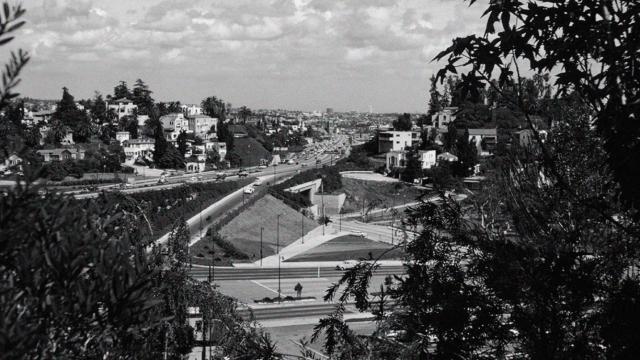Los Angeles is widely considered to be the home of the freeway. It’s also considered to be the home of the film industry. A fascinating story from Nate Berg over at Re-Form chronicles the way that two emerging forces which would come to define LA ended up making the sound of our ever-noisier roadways (somewhat) more tolerable for US residents everywhere.
There are many different definitions of freeway which we could spend all day debating (including what to call them: freeway? highway? parkway?). But the Arroyo Seco Parkway, which opened in 1940 as a corridor from downtown Los Angeles to Pasadena, was the first in the country to be grade-separated — specifically designed to move cars at greater speeds. This also resulted in louder streets from the speedier traffic — something that engineers hadn’t really taken into consideration when building the freeways, which originally simply sliced through existing neighbourhoods. (In fact, it’s the tires that are to blame — which have grown in size from two or three inches in the 1920s to over a foot-wide, making for very noisy streets today.)
It was another LA freeway that opened a few days later, the Cahuenga Boulevard Parkway, which slices through the Cahuenga Pass in Hollywood where the 101 travels today, which would transform the relationship that these highways had to the communities around them. After the Cahuenga Boulevard Parkway opened, it was determined almost immediately that the freeway sound was undermining the performances at the Hollywood Bowl, a large outdoor performance venue adjacent to the new roadway. In 1945, acoustical physicist Dr. Vern O. Knudsen was the first person to recommend a wall especially designed to keep traffic sounds out of the Bowl:
Working with the California Department of Public Works to study road noise near the Hollywood Bowl, that “a wall or parapet, built to a height of at least 10 feet above the promenade walk, be constructed along the southeast corner of the Bowl, thus enclosing the entire seating area with a substantial wall which will serve as a sound screen against street and Freeway traffic noises.” Such a wall, Knudsen suggested, would reduce noise inside the Bowl by up to 6 decibels, equivalent to the noise drop of turning off the TV in your living room.
While the wall itself wasn’t built, Knudsen’s theory encouraged the film industry, which managed freeway-adjacent open-air studio lots, to sponsor some of the first official “sound studies” to figure out how to keep freeway sound at bay:
The Association of Motion Picture Producers teamed up with the Department of Public Works to study freeway noise, and sound engineers from Universal International Studios brought their General Radio sound meters and Magnecord tape recorders to the sides of these new freeways to take measurements. These early studies continued throughout the ’50s and ’60s and helped to set the standards for acceptable levels of noise near freeways.
The first official sound wall was built further north, in 1968 in the city of Milpitas, but noise barriers soon became widespread throughout California. Although these interventions were more to protect commercial concerns at first, the Noise Control Act was eventually enacted in 1972 to prevent local residents from being exposed to excessive freeway noise. As of 2010, there were 2748 linear miles of noise barriers built in the US, according to the Federal Highway Administration.
Thanks to those early collaborations between sound engineers and transportation engineers, data proved that freeway sound was interfering with daily life and designers were tapped to do something about it. Now, if only Hollywood could sponsor a new study that would help us get rid of freeways entirely. [Re-Form]
Picture: The Hollywood Freeway in 1950 via Re-Form
Factually is Gizmodo’s new blog of fun facts, interesting photos and weird trivia.
